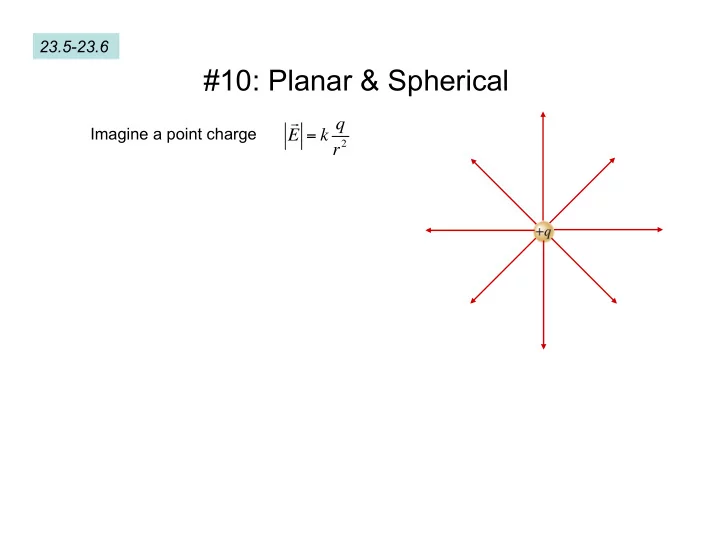

23.5-23.6 #10: Planar & Spherical E = k q Imagine a point charge r 2
Hollow conducting shell E = k q Imagine a point charge r 2 Now surrounded with a neutral conducting shell What’s the electric field? There can be no electric field inside the conductor Field outside is the same What if there are charges/fields outside? The field inside the conductor is zero, but the conductor has no effect on the field outside the conductor! A Faraday cage shield from fields originating from outside. Fields originating inside a Faraday cage freely transmit through the cage You cell phone needs an external antenna to receive, but not to transmit!
Spherical Symmetry What if it is not a point charge, but a thin, uniformly-charged spherical shell (radius R)? Same arguments for apply for r>R: E • d A = EdA Spherical symmetry E • d ( ) = q enc ∫ = ε 0 E 4 π r 2 A ε 0 1 q enc Theorem 1: Any spherically symmetric E = charge distribution acts on particles r 2 4 πε 0 outside the shell as a point charge at the center of the shell. What about r<R? E • d ( ) = q enc = 0 ∫ = ε 0 E 4 π r 2 A ε 0 E = 0 Theorem 2: Any spherically symmetric charge distribution exerts no force on a particle inside the shell.
Spherical Symmetry Therefore, we can find the electric field within any sphericially symmetric charge distribution 1 q enc E = r 2 4 πε 0 For a uniform charge distribution: − 1 $ ' ρ = Q V = Q 4 3 π R 3 & ) % ( − 1 4 3 # & # & # % & $ ' ) = Q 4 ( = Q r q enc = ρ V = ρ 4 3 π R 3 3 π r 3 3 π r 3 % ( % ( & R $ ' $ ' $ ' % ( 1 q enc Q r E = r 2 = R 3 4 πε 0 4 πε 0
Coulomb ’ s Law Gauss ’ Law Consider a spherical Gaussian surface of radius r about a point charge ∫ E • d A = q enc ε 0 Φ = ε 0 E • d A = EdA Spherical symmetry ∫ ∫ E • d A = ε 0 E dA = q enc ε 0 ( ) = q enc ε 0 E 4 π r 2 1 q enc E = r 2 4 πε 0
The figure below shows 3 solid uniform charge distributions each with total charge Q. Rank the electric field at Point P. A. E A = E B = E C B. E A < E B < E C C. E C < E B < E A A B C D. E B = E C < E A
A solid sphere of radius a is concentric with a spherical conducting shell of inner radius 2a and outer radius 2.40a . The sphere has a net uniform charge q 1 ; the shell has a net charge q 2 = -q 1 . What is the magnitude of the electric field at radial distances (a) r = 0 , (b) r = 0.5 a , (c) r = a , (d) r = 1.50a , (e) r = 2.30a , and (f) r = 3.50a ? What is the net charge on the (g) inner and (h) outer surface of the shell? (i) Finally, sketch the electric field as a function of radius.
A solid sphere of radius a is concentric with a spherical conducting shell of inner radius 2a and outer radius 2.40a . The sphere has a net uniform charge q 1 ; the shell has a net charge q 2 = -2q 1 . What is the magnitude of the electric field at radial distances (a) r = 0 , (b) r = 0.5 a , (c) r = a , (d) r = 1.50a , (e) r = 2.30a , and (f) r = 3.50a ? What is the net charge on the (g) inner and (h) outer surface of the shell? (i) Finally, sketch the electric field as a function of radius.
The figure below shows a cross section through a very large nonconducting slab of thickness d = 9.4 mm and uniform volume charge density ρ =5.8 fC/m 3 . The origin of the x axis is at the slab's center. What is the magnitude of the slab's electric field at x = 0, 2.0 mm, 4.7 mm and 20 mm?
Recommend
More recommend